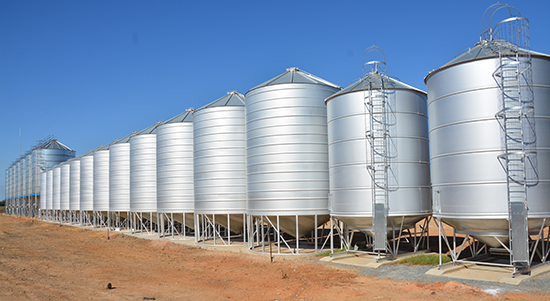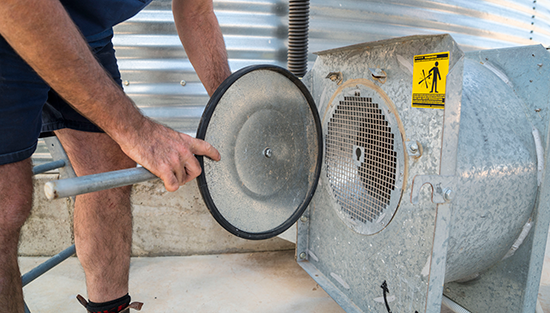Paddock Practices: Five steps for improving on-farm grain storages in dry times
Author: Toni Somes | Date: 01 Mar 2019

If there is an upside to dry times, it would be that grain growers often have more time to tackle maintenance and planning tasks on-farm.
This summer, grain storage expert Philip Burrill is encouraging growers to make the most of having empty or near empty silos and undertake a major clean, alongside repairs, record keeping set-up and long-term planning.
Mr Burrill is a Development Agronomist with the Queensland Department of Agriculture and Fisheries (DAF) and a key researcher with the Grain Research and Development Corporation’s (GRDC) Grain Storage Extension Project.
“Many growers in the northern region were in the unfortunate position of having little or no harvest this past season, which is very challenging from a business perspective,” he said.
“But a positive to come out of the type of season we experienced in 2018 is that dry periods give growers an opportunity to spend time really assessing their grain storage systems.
“This can mean undertaking a major clean, as well as improvements and repairs and maintenance, which can translate to major gains in terms of reducing the risk of storage pest resistance, as well as giving growers a chance to consider long-term plans for on-farm storage facilities.”
Mr Burrill offers five simple steps for growers keen to improve their grain storage systems.
These include:
1.Hygiene
When there is no grain in storage and no old infested grain around the property, you can reduce storage pest numbers to very low levels. This is a good time to ‘land a heavy blow’ on any resistant storage pests.
- Clean out silos and equipment and use a follow-up treat with Diatomaceous Earth (eg Dryacide™).
- Remove any piles of old grain residues that will allow pests to breed.
- Check inside empty silos and grain sheds. Are there changes you could make to improve hygiene? Are there gaps in the silo base or shed floors that trap grain? If yes, fill them with quality gap fillers.
- Check carry over grain or planting seed held in storage for pests. If insects are found, fumigate in a sealable silo with phosphine.
2.Repairs and maintenance
- Do repairs and minor improvements to storage facilities, such as silos and grain sheds. This will improve the efficiency of harvest intake and grain sales out-turn. Fix damaged silo lids and other infrastructure and make any changes that will ensure silos are easier to clean in the future.
- Check grain augers and mobile grain bins and do any repairs and maintenance required.
- Pressure test ‘sealable’ silos. Locate leaks, improve the seal plate design or replace damaged rubber seals. Do pressure testing on completely overcast days, or early morning before sunrise. Check that silos meet the required standard: three minutes half-life pressure test for smaller older silos or five-minute (AS2628) standard pressure test for new and large (> 150 tonnes) silos. An effective fumigation will only be achieved in a gas-tight silo that meets these standards.
- Assess and make any changes that will improve safety around silos. Consider consulting with the appropriate authorities to put powerlines underground in areas where machinery is regularly moving. Small ladders can be made to make access to silos safer. Ensure there is a safe storage area for fumigation products. Have signs or warning tape on hand to indicate silos under fumigation.

3.Aeration cooling
Fit aeration cooling fans to silos that currently have no aeration.
- Add a good quality auto controller to the aeration system, which allows fans to be turned on at optimum times and improves the reliability of cooling systems.
- If you have an existing auto controller, check the temperature and relative humidity readings on the controllers’ sensor with a separate portable reader. Seek advice on how to clean the sensor if dust has built up on it.
- Check older aeration fans. If impeller blades are covered with a build-up of excessive dust, clean them. Cleaning can improve fan performance by 50 per cent.
- Improve the venting on the top of silos for improved efficiency during aeration.

4.Storage records
- Set up a simple storage record keeping system. Keep up-to-date records of grain varieties, qualities and tonnages per silo. Monthly records should include details of any pests found with insect sieve and probe traps, as well as grain temperatures and any treatments applied.
5.Longer term storage facilities planning
Will you need more grain storage space in the future? Consider the economics. More information at http://storedgrain.com.au/economics-booklet.
- Where would you locate the new silos for efficient use during harvest & outturn? More information at http://storedgrain.com.au/grain-storage-facilities.
- What type of storage, size, and brand of silo would you consider? More information at -http://storedgrain.com.au/silo-buyers-guide and in the Kondinin Group research report 'Grain Silos - sealing the deal for quality'
https://www.farmingahead.com.au/category/research-reports. - Consider setting up a small air-conditioned room with grain quality testing equipment, for use during harvest. This will allow you to classify grain and segregate it into silos in parcels that suit the current market. It also provides potential grain buyers or end users with critical grain quality information.
Mr Burrill advises growers to work towards establishing their individual reputations as reliable suppliers of pest-free grain, which meets the quality specifications required by buyers.
Information on all aspects of grain storage can be found on the GRDC resource hub at
https://communities.grdc.com.au/storedgrain.
To listen to the latest GRDC Grain Storage podcast go to:
https://soundcloud.com/grdc/adding-grain-storage-hygiene.
Contact
Toni Somes, GRDC - email toni.somes@grdc.com.au or call 0436 622 645
Was this page helpful?
YOUR FEEDBACK
